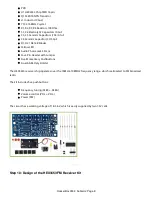
The Airspy software is much easier to use than GNU radio (in my opinion).
The FM transmitter took a while to figure out which frequency it transmitting on. Ultimately mine
was transmitting at about 96Mhz (I found the transmission frequency using Airspy).
Assembled and got the first Pro Micro working a couple of days ago. Can upload the Blink program
and functions fine. However when trying to upload the CC1101_RX or TX program, I get a compile
error indicating WProgram,
from C:\Program Files (x86)\Arduino\libraries\CC1101/ELECHOUSE_CC1101.h:13, then
C:\Program Files (x86)\Arduino\libraries\CC1101/ELECHOUSE_CC1101.h:14:22: fatal error:
WProgram.h: No such file or directory
#include <WProgram.h>
Try replacing "WProgram.h" with "Arduino.h"
Had to replace WProgram.h in both programs (.h and .cpp) . They compile and upload after fixing
the BYTE command in the receiver. Now that they are both uploaded, it just sits and increments a
counter in the receiver from the xmitter. interesting.
what did you do to "fix the BYTE command in the receiver"?
yeah but make sure you do it in both the /ELECHOUSE_CC1101.h and the
/ELECHOUSE_CC1101.cpp files.
I had an awesome time soldering the HEX3653 FM Receiver Kit. After it was done I popped in the
batteries and then fired it up using the jumper to set the headphones as the antenna and at once I
was listening to the local FM stations around here. But as I walked around the house I somehow
managed to cause a short due to exposed batter wires and then after that all that my little Receiver
receives is static and once I press the seek button it receives nothing. I will start troubleshooting
soon but work to the wise be careful with this unit once you add power because you can short it out
any number of ways using the header pins or the power terminals. And this little guy will not hold
up well to shorts!
I'm up and running with the RTL-SDR using SDRSharp. The quick-start quide is spot on. I'm
listening to an old familiar freind on NFM 162.390. If you are in HackerBoxes territory you know
who that is! ;) Now on to GNURadio... Soldering tommorow...
Tim, what machine are you running SDR# on, and where did you get the driver? I tried to install it
on a raspberry pi 3, and a windows vista machine and can't seem to get the proper driver.
Thanks
Joe, after going back and reading it again myself, I see right at the beginning in bold lettering that
XP and Vista are not compatible. :(
I am using Windows 10. I followed the instruction in the guide here ->
https://www.rtl-sdr.com/rtl-sdr-quick-start-guide/
Pay very close attention to steps 7 thru 11 regarding the driver.
Further down below those steps are some additional troubleshooting steps.
HackerBox 0034: SubGHz: Page 14

































